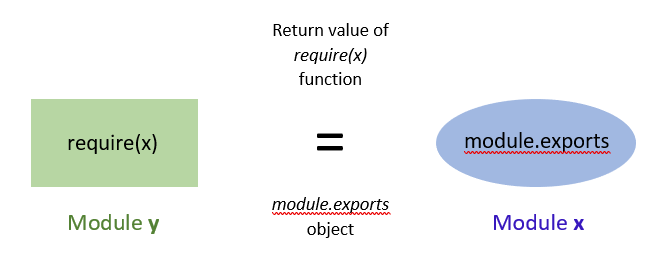🌙 NodeJS之module模块学习笔记

🌙 1.module模块简介
在NodeJS中,每个文件都被视为一个独立的模块。NodeJS默认支持common.js规范。
JavaScript模块化规范(CommonJs AMD CMD UMD ES6) (opens new window)
🌙 2.访问主模块
当 Node.js 直接运行一个文件时, require.main 会被设为它的 module。 这意味着可以通过 require.main === module 来判断一个文件是否被直接运行:
对于 foo.js 文件,如果通过 node foo.js 运行则为 true,但如果通过 require('./foo') 运行则为 false。
因为 module 提供了一个 filename 属性(通常等同于 __filename),所以可以通过检查 require.main.filename 来获取当前应用程序的入口点。
🌙 3.缓存
模块是基于其解析的文件名进行缓存的。 由于调用模块的位置的不同,模块可能被解析成不同的文件名(比如从 node_modules 目录加载),这样就不能保证 require('foo') 总能返回完全相同的对象。
此外,在不区分大小写的文件系统或操作系统中,被解析成不同的文件名可以指向同一文件,但缓存仍然会将它们视为不同的模块,并多次重新加载。 例如, require('./foo') 和 require('./FOO') 返回两个不同的对象,而不会管 ./foo 和 ./FOO 是否是相同的文件。
🌙 4.核心模块
require() 总是会优先加载核心模块(核心模块定义在 Node.js 源代码的 lib/ 目录下)。 例如, require('http') 始终返回内置的 HTTP 模块,即使有同名文件。
🌙 5.循环加载
当循环调用 require() 时,一个模块可能在未完成执行时被返回。
例如以下情况:
a.js:
console.log('a 开始');
exports.done = false;
const b = require('./b.js');
console.log('在 a 中,b.done = %j', b.done);
exports.done = true;
console.log('a 结束');
2
3
4
5
6
b.js:
console.log('b 开始');
exports.done = false;
const a = require('./a.js');
console.log('在 b 中,a.done = %j', a.done);
exports.done = true;
console.log('b 结束');
2
3
4
5
6
main.js:
console.log('main 开始');
const a = require('./a.js');
const b = require('./b.js');
console.log('在 main 中,a.done=%j,b.done=%j', a.done, b.done);
2
3
4
当 main.js 加载 a.js 时, a.js 又加载 b.js。 此时, b.js 会尝试去加载 a.js。 为了防止无限的循环,会返回一个 a.js 的 exports 对象的 未完成的副本 给 b.js 模块。 然后 b.js 完成加载,并将 exports 对象提供给 a.js 模块。
当 main.js 加载这两个模块时,它们都已经完成加载。 因此,该程序的输出会是:
$ node main.js
main 开始
a 开始
b 开始
在 b 中,a.done = false
b 结束
在 a 中,b.done = true
a 结束
在 main 中,a.done=true,b.done=true
2
3
4
5
6
7
8
9
需要仔细的规划, 以允许循环模块依赖在应用程序内正常工作.
🌙 6.文件模块
如果按确切的文件名没有找到模块,则 Node.js 会尝试带上 .js、 .json 或 .node 拓展名再加载。
.js 文件会被解析为 JavaScript 文本文件, .json 文件会被解析为 JSON 文本文件。 .node 文件会被解析为通过 process.dlopen() 加载的编译后的插件模块。
以 '/' 为前缀的模块是文件的绝对路径。 例如, require('/home/marco/foo.js') 会加载 /home/marco/foo.js 文件。
以 './' 为前缀的模块是相对于调用 require() 的文件的。 也就是说, circle.js 必须和 foo.js 在同一目录下以便于 require('./circle') 找到它。
当没有以 '/'、 './' 或 '../' 开头来表示文件时,这个模块必须是一个核心模块或加载自 node_modules 目录。
如果给定的路径不存在,则 require() 会抛出一个 code 属性为 'MODULE_NOT_FOUND' 的 Error (opens new window)。
🌙 7.从 node_modules 目录加载
如果传递给 require() 的模块标识符不是一个核心模块 (opens new window),也没有以 '/' 、 '../' 或 './' 开头,则 Node.js 会从当前模块的父目录开始,尝试从它的 /node_modules 目录里加载模块。 Node.js 不会附加 node_modules 到一个已经以 node_modules 结尾的路径上。
如果还是没有找到,则移动到再上一层父目录,直到文件系统的根目录。
例子,如果在 '/home/ry/projects/foo.js' 文件里调用了 require('bar.js'),则 Node.js 会按以下顺序查找:
/home/ry/projects/node_modules/bar.js/home/ry/node_modules/bar.js/home/node_modules/bar.js/node_modules/bar.js
这使得程序本地化它们的依赖,避免它们产生冲突。
通过在模块名后包含一个路径后缀,可以请求特定的文件或分布式的子模块。 例如, require('example-module/path/to/file') 会把 path/to/file 解析成相对于 example-module 的位置。 后缀路径同样遵循模块的解析语法。
🌙 8.模块封装器
在执行模块代码之前,Node.js 会使用一个如下的匿名函数封装器将其封装:
(function(exports, require, module, __filename, __dirname) {
// 模块的代码实际上在这里
});
2
3
通过这样做,Node.js 实现了以下几点:
- 它保持了顶层的变量(用
var、const或let定义)作用在模块范围内,而不是全局对象。 - 它有助于提供一些看似全局的但实际上是模块特定的变量,例如:
- 实现者可以用于从模块中导出值的
module和exports对象。 - 包含模块绝对文件名和目录路径的快捷变量
__filename和__dirname。
- 实现者可以用于从模块中导出值的
🌙 9.模块作用域
🌙 9.1 __dirname和__filename当前模块的目录名
与 __filename (opens new window) 的 path.dirname() (opens new window) 相同。
示例,从 /Users/mjr 运行 node example.js:
console.log(__dirname);
// 打印: /Users/mjr
console.log(path.dirname(__filename));
// 打印: /Users/mjr
2
3
4
🌙 9.2 exports 快捷方式
exports 变量是在模块的文件级作用域内可用的,且在模块执行之前赋值给 module.exports。
它允许使用快捷方式,因此 module.exports.f = ... 可以更简洁地写成 exports.f = ...。 但是,就像任何变量一样,如果为 exports 赋予了新值,则它将不再绑定到 module.exports:
module.exports.hello = true; // 从模块的引用中导出。
exports = { hello: false }; // 不导出,仅在模块中可用。
2
当 module.exports 属性被新对象完全替换时,通常也会重新赋值 exports:
module.exports = exports = function Constructor() {
// ...
};
2
3
为了说明这种行为,想象对 require() 的假设实现,它与 require() 的实际实现非常类似:
function require(/* ... */) {
const module = { exports: {} };
((module, exports) => {
// 模块代码在这。在这个例子中,定义了一个函数。
function someFunc() {}
exports = someFunc;
// 此时,exports 不再是一个 module.exports 的快捷方式,
// 且这个模块依然导出一个空的默认对象。
module.exports = someFunc;
// 此时,该模块导出 someFunc,而不是默认对象。
})(module, module.exports);
return module.exports;
}
2
3
4
5
6
7
8
9
10
11
12
13
🌙 9.3 module对象
module.children:module[] 被该模块引用的模块对象。module.exports: objectmodule.exports对象由Module系统创建。module.filename: string模块的完全解析后的文件名。module.id: string模块的标识符。 通常是完全解析后的文件名。module.loaded:boolean模块是否已经加载完成,或正在加载中。module.parent: moduls最先引用该模块的模块。module.paths: string[]模块的搜索路径。module.require(id): id string, 返回: any (opens new window) 导出的模块内容。module.require()方法提供了一种加载模块的方法,就像从原始模块调用require()一样。为了做到这个,需要获得一个
module对象的引用。 因为require()会返回module.exports,且module通常只在一个特定的模块代码中有效,所以为了使用它,必须显式地导出。